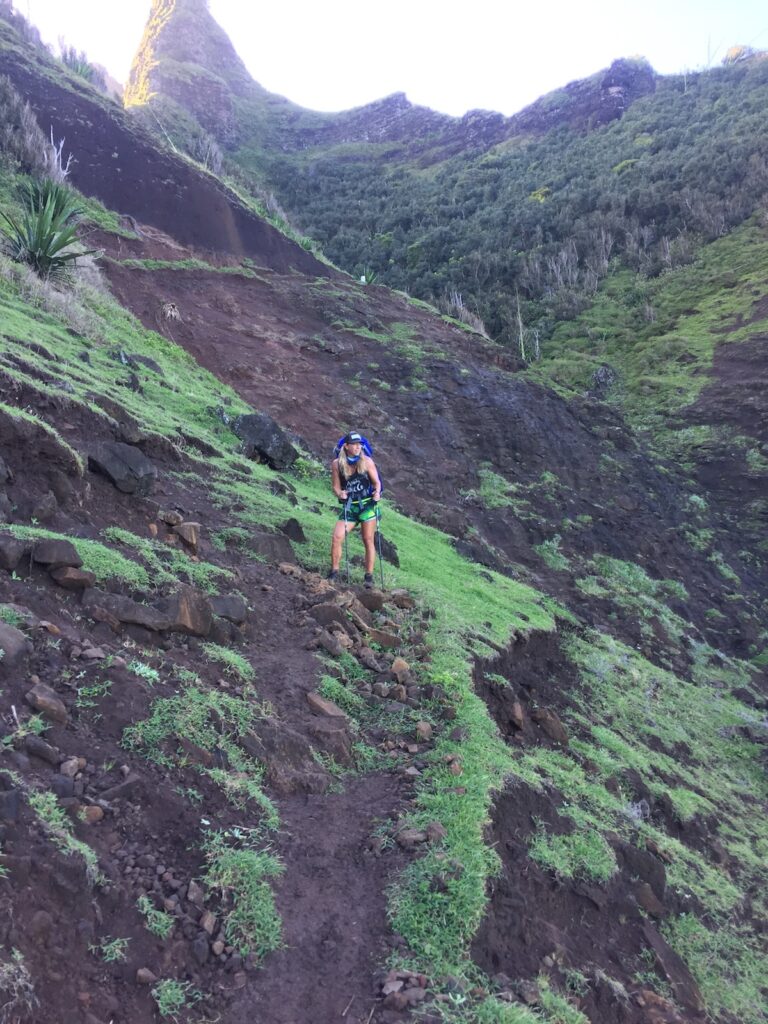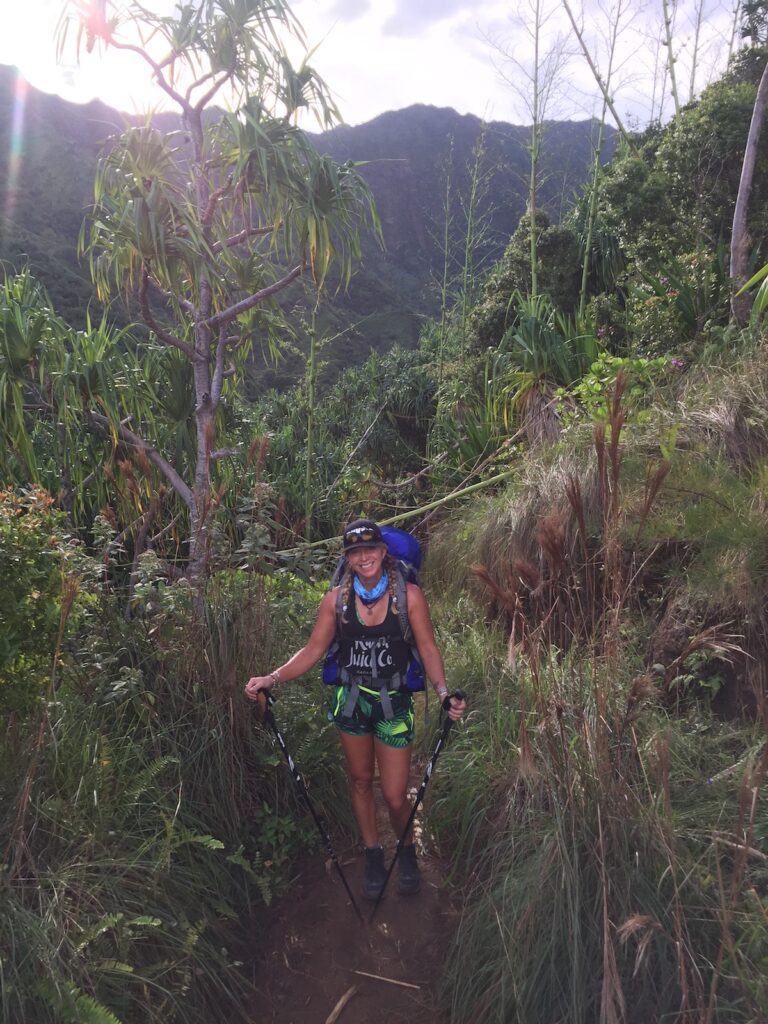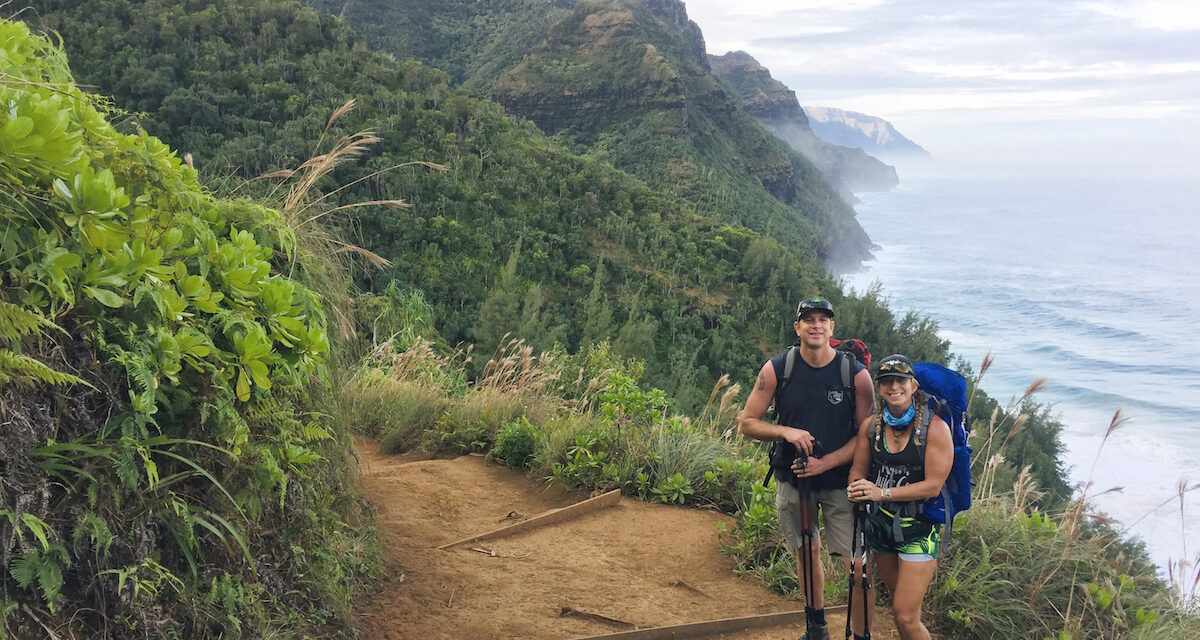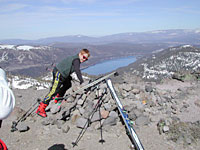- Five Tips for Cleaner Adventure Camping - 02/19/2024
- Uncommon Journey - 01/02/2024
- Bike Parks - 09/06/2023
Kaua‘i’s Nāpali Coast
Hiking the Kalalau Trail: We lucked out, the weather was perfect for the start of our 22-mile journey. The day was January 31 and it was my husband’s birthday. The sky was slightly overcast, keeping the sun from beating on our shoulders, but by mile 2, I was already drenched with sweat. I sweat a lot anyway, but the humidity tipped the scales and this being my fifth year as a resident of the North Shore, I thought I’d be more acclimated. But nothing can really prepare you for the Kalalau trail on the Nāpali Coast of Kaua‘i. It is jaw-droppingly beautiful. Mountain peaks above, sheer cliffs below with crashing turquoise blue surf. It is rocky, muddy, slippery and at times yes, dangerous.
The Nāpali Coast in Kaua‘i is considered by many to be one of the most beautiful places on the planet. I am one of those people and after hiking the famed Kalalau Trail, I believe it to be even more so. This trail holds the history of ancient Hawaiian civilization and every step embeds you in Kaua‘i history and its red dirt.Hiking the Kalalau Trail: If you’re craving a real Kaua‘i adventure, here are some tips to get you started and stoked.
Things have radically changed on the North Shore of Kaua‘i in recent years. The April flood of 2018 caused numerous land slides that cut off the entire North Shore past Hanalei for over a year. Only residents that lived in the affected area could gain entry. It became the North Shore of 40 years ago. Then COVID-19 hit and the entire island became the Kaua‘i of days gone past. Despite the financial hardships the pandemic brought, many locals and residents loved it. It was uncrowded and even the reefs and wildlife benefited from the lack of tourists. So, the first bit of advice is to please Mālama ‘Āina which is the Hawaiian way of saying “take care of the land.” This basic saying should be instinctive: don’t litter, pick up trash, and recycle. But it’s not just for the land, it’s also for the people. Aloha will flow to you if you embrace this attitude.
You will need planning and reservations. Planning is key, as this trail is no joke. It’s 11 miles each way and if you are afraid of heights or not in good shape, skip this one.
Even though the trail starts and ends at sea level, it crosses numerous valleys and ridges for a one-way total elevation gain of almost 5,000 feet. Plan for at least two nights, three is better. The time of year isn’t much of a problem, but check the weather as heavy rain will make the hike not advisable and at times the state will even close it for safety. The trail has numerous river crossings that become dangerous to pass every year. Dozens of hikers get stranded and worse. Getting washed away, never to be found, is a rare but real danger. The Kalalau Trail is listed as one of the world’s most dangerous hikes for a reason, but with risk comes reward.

Once you get your permits, your next step will be packing. There are no provisions past Hanalei so you will need to pack all your fuel and food. The good news is there are plenty of water sources along the way, but you’ll need a purification pump or tablets.
Depending on your comfort level, plan on carrying a pack that weighs 10% to 20% of your body weight. For example, my weight is 140 pounds and I carried the max, a 28-pound pack. This may sound like a lot, but I like to eat and drink, so the extra weight was worth it. My husband, at 200 pounds, donned a 40-pounder for our four-day trip. I like comfort, so we brought our full adventure kit, which consists of a tent, air pads and pillows, mini stove, fuel, pan and pot, utensils and a couple of nice cups. We ate like kings, carrying avocados, bread, and even potatoes and onions to sauté with bits of peppered salami. We also brought surprisingly delicious MREs to complement our warm whiskey cocktails.
As for the trail, be prepared to be sunned and stunned by vistas and mountain ridges at every turn. I recommend a pair of hiking poles. Although I’d never used them before this trip, they saved me more than once from a fall and this is not a place to twist an ankle.
There is a camping area at mile 6 in Hanakoa Valley, with a great waterfall hike just half a mile from the camp. We happily camped there our first night and enjoyed the company of a few other fellow hikers who were on their return leg. They swapped stories of their trip and the impending “Crawler’s Ledge” section at mile 7.

I’m glad we had the night to recover, allowing us to tackle this most dangerous section of the trail on fresh legs. And it was a very good decision for us, as we watched a group ahead of us attempt to cross and return wide eyed from the ledge, saying it was “too dangerous to pass.” I looked at my husband and then down at the ledge and ocean below. The wind was whipping pretty good with a slight drizzle. Then my husband pointed to a perfect rainbow stretched across the sea; it was all I needed to continue. As I approached the ledge, I could clearly see the key steps carved out in the mountain, the same steps ancient Hawaiians took for hundreds of years along this trail. It was as if they illuminated before me. Once safely passed, we stopped for a moment and just took it all in. The adventure gods were smiling and so were we. Damn thrilling it was!
The rest of the hike was a dream. Wild goats roam the trails, offering a bleat or two along the way. Then Kalalau Valley lays out before you with a single palm tree guiding you to the beach. Taking my boots off and hitting the sand was like a hot shower, just deliciously good! We decided to spend our last two nights at the beach enjoying the sun and solitude and tackle the entire 11-mile return in one day. We made it back tired and elated and vowed to make an effort to hike it every year for as long as we can. It’s just that good.
Permits and Info
For permits, go to camping.ehawaii.gov and follow the instructions for making a reservation in Nāpali Coast State Wilderness Park. You can make reservations up to 30 days in advance and it is $35/per person per night. Yes, there is a park ranger at the parking lot gate who will verify your name and reservations. You will also need to reserve parking after you confirm your reservations at gohaena.com. The Department of Land and Natural Resources (DLNR) posts a red banner for any closures and also provides great safety and trail descriptions on their website, dlnr.hawaii.gov – just search Kalalau Trail.
If you want to get a taste of the trail without the overnight commitment, you can hike the first two miles without a permit. You will need a parking reservation made in advance at gohaena.com, and be back at your car by sunset.
For the latest travel quarantine regulations go to kauai.gov. Hiking the Kalalau Trail
















